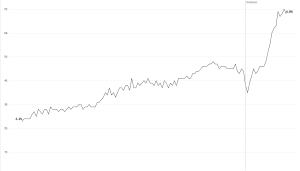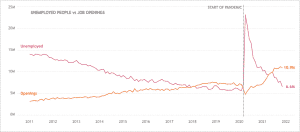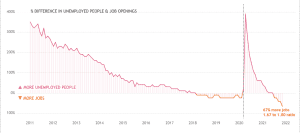Over the past two years, the Recovery Decision Science Business Intelligence team has tracked U.S. unemployment trends from a variety of angles:
- Initial unemployment claims (national, statewide, county)
- Month to month
- Year to year
- Unemployment rate by:
- Education level
- Gender
- Race & ethnicity
- Age range
- Industry
- Occupation
To see all of the interactive unemployment workbooks, go to the RDS TABLEAU PUBLIC page.
Whereas unemployment was the overarching economic story in the months following the worst of the pandemic, the narrative has shifted dramatically in the past year.
Dubbed the “Great Resignation,” millions of Americans have walked away from their jobs just as the economy was beginning to recover from the Covid-19 economy. Perhaps cushioned by government stimulus checks and extended unemployment support, many Americans have used this period to reassess the meaning of work in their lives. This shift has created a “buyer’s market” for workers who are searching for better pay, greater security, and more flexibility in their work lives.
With the Great Resignation as a backdrop, the RDS Business Intelligence team recently developed a new set of interactive workbooks on their Tableau Public site. “Job Openings and Labor Turnover” includes nine dashboards that take a deep dive into various aspects of the Great Resignation.
CLICK HERE to go to the Job Openings and Labor Turnover page on Tableau Public.
OVERVIEW
As you can see in the screenshot below, 6.8% of non-farm jobs remain open as of the most recent report from the Bureau of Labor Statistics.

The current job opening rate is more than three times the 2.3% rate we saw in the aftermath of the Great Recession.
For reference, a job is considered “open” if it meets all three of the following variables:
- A specific position exists (full or part-time) and there is work available for that position.
- The job could start within 30 days.
- The employer is actively recruiting from outside the organization.
Not surprisingly, the industry that suffered the most from the Covid-19 shutdowns is now feeling the greatest brunt of the Great Resignation. In the months following the shutdowns, unemployment rates in Leisure and Hospitality topped a staggering 40%. Currently, this industry’s job opening rate in the same industry is 10.0%, or 30% higher than the national non-farm average.
HIRES VS. SEPARATIONS
Perhaps the most telling statistic to put context around the Great Resignation is the relationship between hires and separations. Let’s define each:
- Hires include all additions to the payroll during the reference month, such as newly hired or newly rehired employees.
- Separations reflect all separations from the payroll: quits, layoffs, discharges and other separations, not including retirements.
Below is a screenshot from the workbook.
Here’s what we see:
- In the months leading up to the pandemic, the hire rate (green) stayed slightly ahead of the separation rate (yellow).
- Then, in March 2020, as the economy went into shutdown mode, the separation rate hit an astounding 75.8.
- By May 2020, we saw a dramatic swing in the opposite direction as the hiring rate hit 63.3%.
- As of the most recent report, the gap is beginning to return to pre-pandemic levels, but there is still a 4-point spread between the separation and hiring rates.
UNEMPLOYED PERSONS VS. JOB OPENINGS
Finally, we look at the gap between current job openings and unemployed persons, both from a raw data perspective as well as the percentage difference between the two measures. See the screenshots below:

As you can see, there are currently 3.3 million (or 67%) more open jobs than there are unemployed persons. This is the highest gap in recent history. Although, it’s worth noting that for much of 2019, the jobs-to-unemployed persons gap hovered in the still-high 25% range, suggesting that the seeds of the Great Resignation were already taking root.
Again, CLICK HERE to go to the Job Openings and Labor Turnover page on Tableau Public.
To learn more about Recovery Decision Science contact:
Kacey Rask : Vice-President, Portfolio Servicing
[email protected] / 513.489.8877, ext. 261


